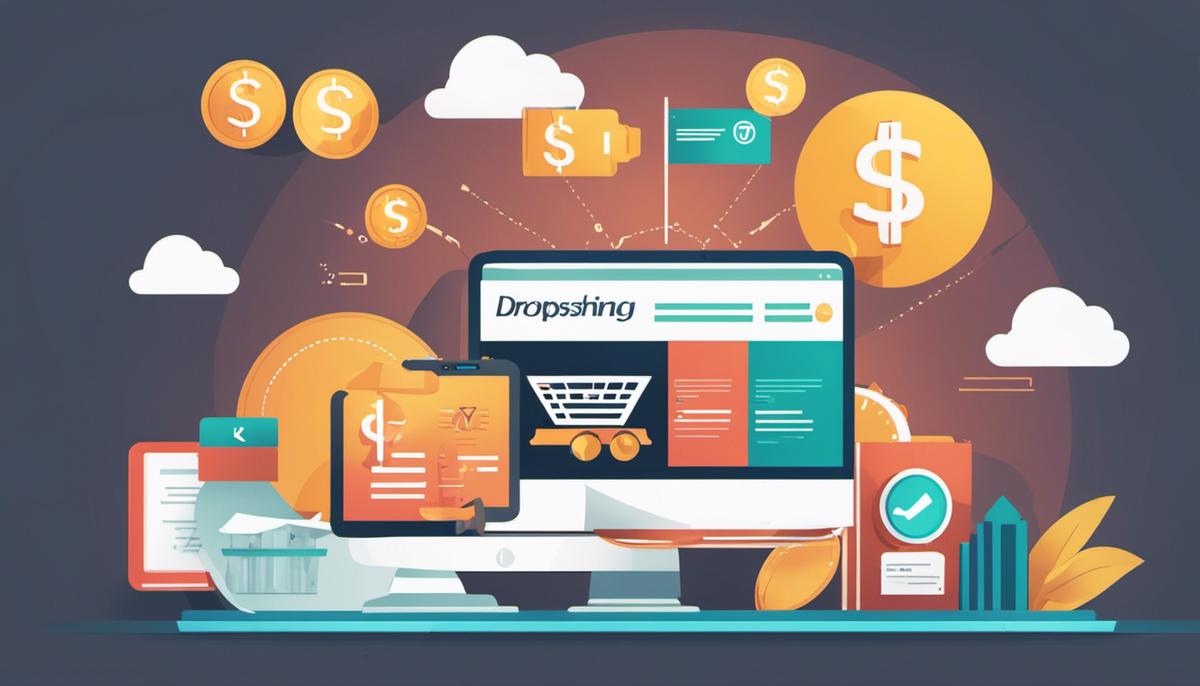BetterYouJourney.com is a participant in the Amazon Services LLC Some of the links in our posts are affiliate links. Click here to see full Disclosure.
In the ever-evolving landscape of e-commerce, dropshipping has emerged as a popular method for sellers to optimize their businesses. It revolutionizes the retail model, enabling businesses to sell products directly from suppliers to customers, thus eliminating the need for stockpiling inventory. Through this essay, we aim to demystify the concept of dropshipping, outlining its fundamentals, pros and cons, underlying processes, and strategies for success. Whether you’re a seasoned seller seeking to diversify your business operations or a budding entrepreneur stepping into the realm of e-commerce, this comprehensive guide is intended to equip you with a well-rounded understanding of dropshipping.
Understanding the Basics of Dropshipping
Understanding Dropshipping
Dropshipping is a retail fulfillment method where a store doesn’t keep the products it sells in stock. Instead, when a store sells a product using the dropshipping model, it purchases the item from a third party, typically a manufacturer or wholesaler, who then ships it directly to the consumer. As a result, the seller doesn’t need to handle the product directly. The biggest difference between dropshipping and the standard retail model is that the selling merchant doesn’t stock or own inventory. Instead, the seller purchases inventory as needed from a third party to fulfill orders.
Key Players in Dropshipping
A dropshipping model primarily involves three key players: the retailer, the supplier, and the consumer. The retailer is the entity that sells the product but does not keep goods in stock. They liaise with the supplier to ensure products are shipped directly to customers. The supplier produces the products and ships them on behalf of the retailer which essentially makes them the link in the chain that enables dropshipping. The customer is the final piece of this puzzle, buying products from the retailer, however, often unaware that the retailer is not the one shipping the products.
Differentiating Dropshipping from Traditional Retail
The traditional retail model involves purchasing a bulk quantity of products from a supplier, storing them in a warehouse, and then selling and shipping those items to end customers. This process requires a significant upfront investment, storage space, and an efficient logistics team to manage inventory and shipping. On the other hand, dropshipping allows retailers to evade these challenges. A dropshipping retailer doesn’t own or stock items but instead places orders with the supplier or manufacturer only after customers have made purchases. The items are then shipped directly by the supplier to the end customer.
Advantages and Disadvantages of Dropshipping
One major advantage of dropshipping is that it’s accessible to anyone with an ecommerce platform. It eliminates the need for physical inventory and reduces overhead costs. Additionally, the range of products that can be offered via dropshipping is extremely wide, depending on supplier availability.
However, dropshipping isn’t without its drawbacks. Prices may be higher from dropship suppliers compared to buying in bulk from a wholesaler. It also leaves the retailer less control over shipping processes and times, and any supplier error reflects directly on the retailer. Furthermore, the process of communicating with the suppliers and managing the customers’ orders, which may be from different suppliers, can sometimes be complicated.
To assess if dropshipping is a fitting option for your specific needs, you need to understand its fundamental principles, potential challenges, and benefits. Utilizing this method can aid retailers in broadening their offerings and potentially boost their business growth, granted they manage the process in an efficient and effective manner.

Analyzing the Pros and Cons of Dropshipping
Why Dropshipping is Attractive
Dropshipping stands as an appealing business proposal for numerous reasons, the quintessential one being its cost efficiency. As a dropshipper, you eliminate the need for inventory management or storage, saving not just money but also allowing you to concentrate your efforts on marketing and business expansion. In addition to saving resources, this lack of inventory facilitates adaptability – businesses can swiftly update their online offerings to fall in line with fluctuating market trends and customer preferences.
A vast array of products is readily available and accessible for dropshippers, eliminating the need to fret about sourcing products themselves. Plus, dropshipping can be done from essentially any location worldwide as long as there is a reliable internet connection in place. This geographic freedom, coupled with an extensive product range, significantly reduces the hurdles for entry, thus making dropshipping an astute choice for budding entrepreneurs.
Another advantage to consider is the low-risk nature of dropshipping. Unlike traditional retail operations, dropshipping doesn’t require you to make substantial upfront investments to start or maintain your store. For instance, if a product’s demand falls, there aren’t any assets to dispose of or surplus inventory to manage.
The Ups and Downs of Dropshipping
Dropshipping, as advantageous as it can be, brings along its own set of challenges. A foremost one is errors made by suppliers. Although the retailer is the interface that the customer interacts with, they barely have any control over the product’s shipping and handling. This means, supplier-induced issues like late or wrong deliveries, and improper packaging can negatively affect the retailer’s image.
Manageable inventory is also a significant obstacle in dropshipping. Retailers, not having direct control over stock, can face stock level discrepancies. If a supplier runs out and fails to notify on time, it can lead to unfulfilled orders, leading to dissatisfied customers.
The cut-throat competition is yet another issue. To draw in customers, most retailers end up reducing prices which tends to limit the profit margins. This means, to make a good profit, high sales volumes become imperative.
A final significant challenge lies in managing customer service. Cases where customers need to return or exchange products can be complex for businesses with no direct control over fulfillment. Hence, worthwhile dropshipping necessitates nurturing sturdy relationships with trustworthy suppliers and maintaining clear and timely communication with customers.

Navigating the Process of Setting Up a Dropshipping Business
Finding the Perfect Niche and Product for Dropshipping
When exploring the terrain of a dropshipping business, the first path to tread is identifying a specific market niche. This segment can cater to interests poorly satisfied by current suppliers or retailers. The niche could encompass a wide range of goods— from vintage watches or organic pet food, to sustainable fashion or pop-culture collectibles, etc. While picking out a niche, it’s vital to strike a balance between your personal penchant for the product and its corresponding demand in the market.
Finding Suppliers for Dropshipping
Once you’ve identified your niche product, the next crucial step is finding reliable, straightforward suppliers. This stage often requires considerable research and networking. You could either approach manufacturers directly or go through wholesale directories. When dealing with suppliers, it is crucial to consider factors such as delivery times, product quality, and communication efficiency. It is recommended to order a sample product to evaluate the quality and assess the delivery process firsthand.
Establishing an Online Store
Setting up a dropshipping business requires an e-commerce platform to host your online store. There are numerous platforms available such as Shopify, BigCommerce, WooCommerce, etc., which support dropshipping businesses. These platforms help you manage inventory, add or remove products, take payments, and fulfill orders. Each platform has its perks and drawbacks. Hence, entrepreneurs should carefully compare costs, features, and user experience before making a decision. It’s also important to consider adding important policies to your site such as return policies, terms of service, and privacy policies.
Marketing Your Products
Once your store is live and stocked, you need customers. This often means investing in marketing. The various marketing channels include social media, SEO, content marketing, email marketing, and paid advertising. Social media platforms such as Instagram, Facebook, and Pinterest can be particularly beneficial for visual products. SEO, or search engine optimization, involves optimizing your website and its content to rank higher in search engine results, thereby increasing its visibility. Content marketing involves creating and sharing online content such as blog posts, videos, and social media posts, to stimulate interest in your products.
Customer Service in Dropshipping
Managing customer service effectively is essential for any business, especially for e-commerce. Customer service in dropshipping includes responding to customer inquiries, handling returns and refunds, and dealing with complaints or issues with orders or products. Having an efficient system to tackle these issues can significantly enhance the customer shopping experience, leading to repeat business and positive reviews. This also involves being transparent with your customers about shipping times and any potential delays, which are more common in dropshipping businesses due to the dependence on third-party suppliers.
Understanding the Legalities and Formalities of Dropshipping
Before launching your own dropshipping business, it’s important to familiarize yourself with the legalities and formalities involved. This includes business registration, securing an EIN (Employer Identification Number), and establishing your tax process. The specific requirements may differ depending on your location and the type of product you intend to sell. Consulting with a legal expert to ensure all these aspects are properly addressed is highly beneficial. By sorting out these details early on, you can prevent potential disputes or challenges further down the line.

Photo by petrebels on Unsplash
Exploring Strategies for Successful Dropshipping
The Dropshipping Business Model Explained
Now that you are aware of the legalities and formalities, let’s delve into what dropshipping actually entails. In essence, dropshipping is a retail model where the seller doesn’t keep the products in stock. Instead, they forward customer orders to a manufacturer, another retailer, or a wholesaler. The latter then dispatch the products directly to the client. This makes the whole process more streamlined and cost-effective for you, the seller.
Essential Strategies for Successful Dropshipping
While it seems easy, successful dropshipping requires wise strategies and considerations. First, selecting the right product and niche is crucial. Picking up an oversaturated product may leave you struggling for visibility, while very niche products might not have a large enough customer base. Engaging in market analysis and trend prediction can be vital here.
Next, maintain a competitive edge by offering high-quality products, lower shipping costs, excellent customer service, and effective marketing strategies. Being able to quickly process refunds, handle returns, and provide prompt customer support can also significantly improve your customer satisfaction rate.
Lastly, find a reliable supplier. Having a trustworthy supplier ensures efficient and timely delivery to prevent order delays or cancellations. Establishing a solid relationship with your supplier is essential.
Increasing Sales in Dropshipping
To boost your sales, focus on marketing your products effectively. This could mean using social media, email marketing, content marketing, and SEO. Offering incentives such as discounts or free shipping can also attract more customers and drive purchases. Lastly, utilizing tools like Google Analytics can promote data-driven decision-making, knowing what works, and applying those strategies effectively.
Tackling common Dropshipping Problems
Despite being a profitable model, dropshipping has its own set of challenges. One of the first issues faced by dropshippers is dealing with long shipping times due to the location of suppliers. To combat this, it’s recommended to be transparent about shipping times and to choose manufacturers strategically, giving preference to those closer to your customer base.
Inventory problems can also arise when suppliers run out of stock without notifying the dropshipper. Using inventory management software can provide live updates on the availability of products.
Learning from Successful Dropshippers
Learning from successful dropshippers can help you save time and avoid making common mistakes. For instance, most successful dropshippers emphasize the importance of marketing. This means going beyond product listings to engage with potential customers through blogging, social media, and email marketing.
Moreover, successful dropshippers often use a wealth of tools and automations to streamline their operations. From inventory management software to customer relationship management (CRM) platforms, these tools can help you maintain efficiency and improve customer service.
Lastly, patience and perseverance stand at the heart of every successful dropshipping business. As with any business, dropshipping requires dedication, hard work, and time to flourish and become profitable.

Despite the potential challenges associated with dropshipping, with the right approach and strategies, it can prove to be a viable avenue for e-commerce success. The key lies in meticulous planning during the setup phase, careful selection of niche and suppliers, effective marketing, and excellent customer service. Furthermore, constant learning, adaptation, and innovation are crucial in the competitive e-commerce sphere. As you navigate your dropshipping journey, remember that the rewards of a successful dropshipping venture – low upfront investment, flexibility, and the ability to offer a wide selection of products – make the endeavor worthwhile.








